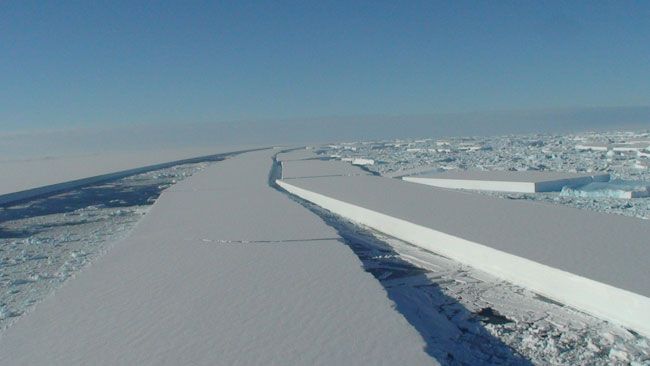Antarctic Ice Causes Glacial 'Earthquakes'

Scientists have discovered their first icequake, if you will — a movement of a huge stream of ice in Antarctica that creates seismic waves, just like an earthquake, and can be felt hundreds of miles away. Starting in 2001, Douglas Wiens of Washington University in St. Louis deployed seismographs around Antarctica, which detected seismic signals between that year and 2003. "At first we didn't know where the waves were coming from, but eventually we were able to narrow down the source to the ice stream," Wiens said. These ice-driven seismic waves had the force of a magnitude 7 earthquake, he said. That's equivalent to the strength of the 2005 Fukuoka earthquake, which killed only one, but displaced more than 3,000 people. Glacial earthquakes Prior to Wiens' discovery, detailed in the June 5 online issue of the journal Nature, scientists were unaware that ice streams radiated seismic waves (though they had detected them from glaciers, mainly near Greenland). Ice streams are pieces of a bigger ice sheet that can move faster than the surrounding ice, periodically sliding over the underlying bedrock and eventually working their way to the coastline, where the ice can calve off to create icebergs. The particular ice stream that created the seismic signals Wiens detected was 500 miles away from the seismographs that detected it. It is about 60 miles wide and half a mile thick. Each time it moves, it gives off seismic waves that are recorded at seismographs all around Antarctica, and even as far away as Australia. The seismic waves Wiens measured came in two bursts every day; each one was equivalent to a magnitude 7 earthquake. "By some measures, the seismic impact is equivalent to a very large earthquake, but it doesn't feel like it because the movement is much slower than a real earthquake," Wiens said. Wiens' data show that the river of ice moved about 18 inches (46 centimeters) in 10 minutes, then remained still for 12 hours, and then moved another 18 inches. An earthquake of a similar size would be over in just 10 seconds, Wiens noted.
"I guess you could call [this] an earthquake at glacial speed," Wiens said. Sticking and slipping GPS instruments placed directly onto the ice stream can detect where the ice sheet begins to slip and where it stops (similar to the classic "stick-slip" motion of an earthquake fault where the plates on either side of the fault are "stuck" by friction until the stress builds up and the fault suddenly slips), Wiens said. "The slip starts in a certain part of the ice stream and then it moves out, rather like a landslide might start at a certain point and then move out to envelope an entire mountainside," Wiens explained. "The GPS tells us which part moves first and what other parts moved next and so forth." The GPS data show that the slip always starts form the same spot on the bed of the ice stream, which glaciologists call a "sticky" spot because it creates more friction than the surrounding part of the bed. Glaciologists had previously thought that glacier and ice streams moved in a continuous creep, "but now this indicates that they move with a fast slip, almost like an earthquake," Wiens said. Wiens says that understanding this stick-slip movement of ice could provide a clue as to why ice sheets and glaciers can speed up or slow down over many years. "This particular ice stream has been slowing down over the last few decades, and no one knows why," said Wiens, whose work was funded by the National Science Foundation. "We need to understand what controls the speed of the ice streams, because that will affect how fast the ice in Antarctica will go away and sea level will rise as global warming melts the West Antarctic Ice Sheet," he added.
- Video: Under Antarctic Ice
- Video: Learn How Ice Melts
- Images: Ice of the Antarctic
Sign up for the Live Science daily newsletter now
Get the world’s most fascinating discoveries delivered straight to your inbox.

Andrea Thompson is an associate editor at Scientific American, where she covers sustainability, energy and the environment. Prior to that, she was a senior writer covering climate science at Climate Central and a reporter and editor at Live Science, where she primarily covered Earth science and the environment. She holds a graduate degree in science health and environmental reporting from New York University, as well as a bachelor of science and and masters of science in atmospheric chemistry from the Georgia Institute of Technology.











